Long overdue, but sometimes things don’t quite work out as planed. Ever since the Bright tradeshow in January 2012 it was a done deal to review this newest Scott Johnston-designed masterpiece. It’s a bold statement that proves that small skate shoe brands are not just doomed to follow.
High quality PDF-file:Lakai Marc review
Lakai has trekked through some rough waters during the last year and a half. If you aren’t familiar with their history, they made an executive decision to move under the same roof as Girl Skateboards, had some big names quitting, even more young guns joining, and switched production factories. However, Lakai keeps battling David-esque against all the Goliaths on the market and refuses to settle with “average”. To a certain degree, the Lakai Marc is the prey (check the commercial on Lakai.com) of the hunt for excellence. Produced in South Korea, the Lakai Marc is the brainchild of Team Johns(t)on; it is designed by Scott Johnston, and approved by long-term team rider Marc Johnson. How it fulfills its purpose on the board can be read in the following review.
The Lakai Marc fits true to size.
The one-piece toebox design is one of the Lakai Marc’s features, but nowadays, this design alone has almost become the industry norm due to its superior durability. No additional panels in the toebox area means no separating layers from ripped stitching. Furthermore the one-piece toebox design offers one expansive contact area rather than single area points for attack.
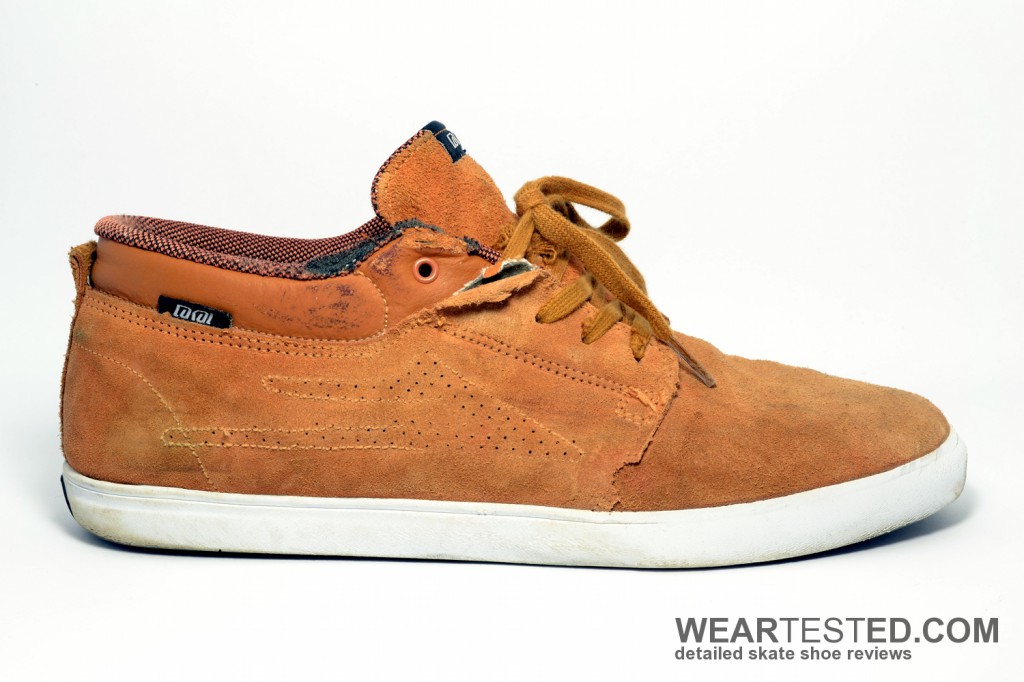 The Marc successfully avoids several small yet commonly seen durability flaws. The transition between a shoe’s frontal area and sidewall is typically the most critical area. However, Lakai did everything right in this case: the panels are glued together and not just stitched, the interference of the layers is big and a threaded square near the eyestay secures the connection. Furthermore, the Lakai Flare is not an extra layer, but instead shown through decorative stitching and perforations. As a result, it can’t peel off and suits the overall minimalist, desert-boot inspired design very well. Surprisingly for such a seemingly subtle design, a second layer lace protection has been incorporated. As can be seen in the pictures, it worked well during the 10-hour test and the laces stayed intact. Both the bottom and outsole proved to be durable as well. The deep sole pattern shows wear but only minor areas are completely flat.
The Marc successfully avoids several small yet commonly seen durability flaws. The transition between a shoe’s frontal area and sidewall is typically the most critical area. However, Lakai did everything right in this case: the panels are glued together and not just stitched, the interference of the layers is big and a threaded square near the eyestay secures the connection. Furthermore, the Lakai Flare is not an extra layer, but instead shown through decorative stitching and perforations. As a result, it can’t peel off and suits the overall minimalist, desert-boot inspired design very well. Surprisingly for such a seemingly subtle design, a second layer lace protection has been incorporated. As can be seen in the pictures, it worked well during the 10-hour test and the laces stayed intact. Both the bottom and outsole proved to be durable as well. The deep sole pattern shows wear but only minor areas are completely flat.
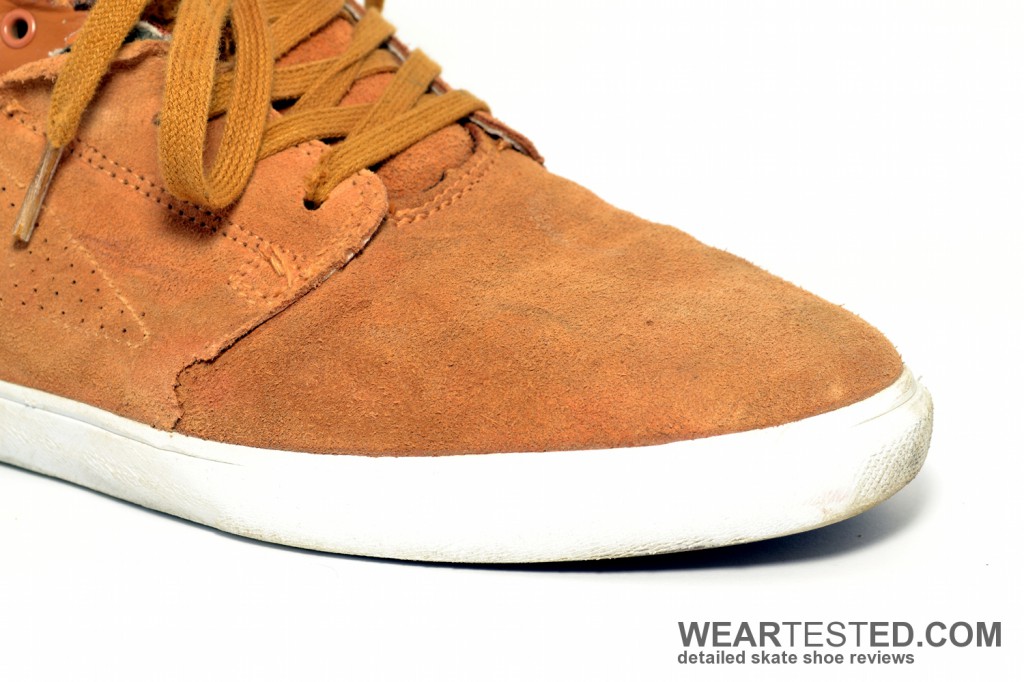 The additional toebumper, which unfortunately is not an industry standard anymore, was worn down, but there are no grooves in the transition area between upper and sole. This is a clear sign for good durability, especially for a vulcanized construction.
The additional toebumper, which unfortunately is not an industry standard anymore, was worn down, but there are no grooves in the transition area between upper and sole. This is a clear sign for good durability, especially for a vulcanized construction.
The sole of the Marc consists of a thin rubber bottom in combination with thick removable insole. The increasing thickness towards the back to a maximum thickness of 0.43-inch is the primary reason for the solid impact protection.
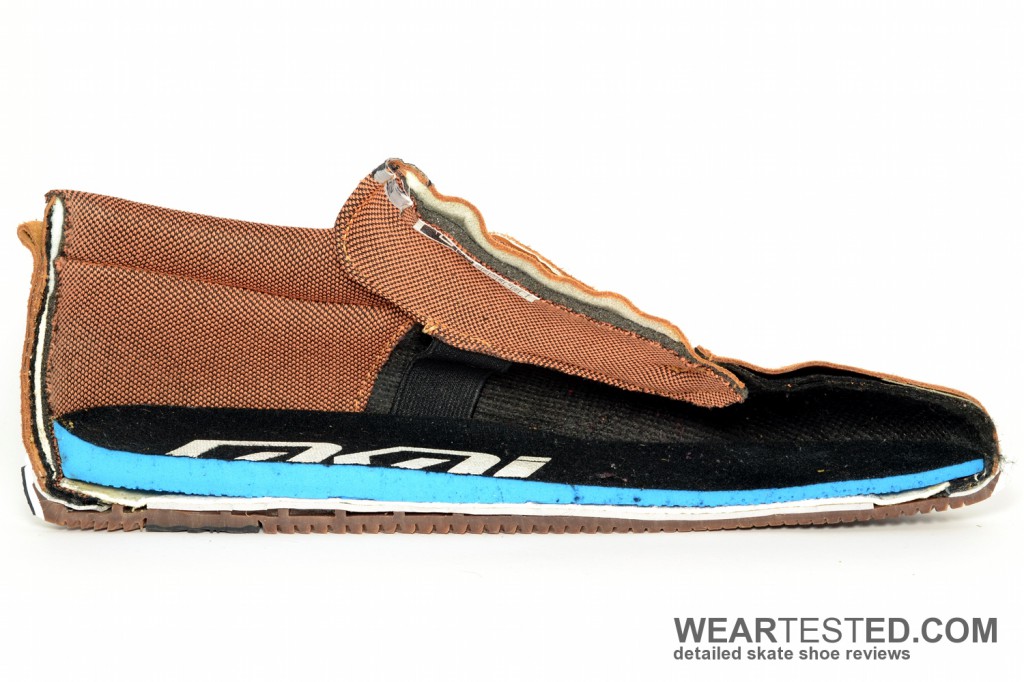 This construction allows for board feel in the front while the heel area is able to dampen the common impact forces from flatground and ledge skating very well. The foam of the insole is rather soft in comparison. Since the insole is only responsible for the cushioning, bigger impacts seem to cause a complete compression and thereby set a limit to the impact absorption of the whole shoe.
This construction allows for board feel in the front while the heel area is able to dampen the common impact forces from flatground and ledge skating very well. The foam of the insole is rather soft in comparison. Since the insole is only responsible for the cushioning, bigger impacts seem to cause a complete compression and thereby set a limit to the impact absorption of the whole shoe.
The first half of the shoe from the tip to the arch is mainly responsible for the boardfeel. The Marc is able to provide two assets in this area. The first is a thin front of the removable insole as well as a thin bottom sole. This causes a direct contact between foot and board. The second is the flexibility, which allows a maximum contact surface and causes the shoe to adapt well to the concave of the deck. The boardfeel is overall balanced; you can feel the deck but certain cushioning is still noticeable, which helps make bails bearable.
Lakai keeps it classic with the Marc’s herringbone sole. The zig-zag pattern has proven to offer a grippy connection between the deck and sole as long as it is a softer rubber mixture and the grooves are deep.
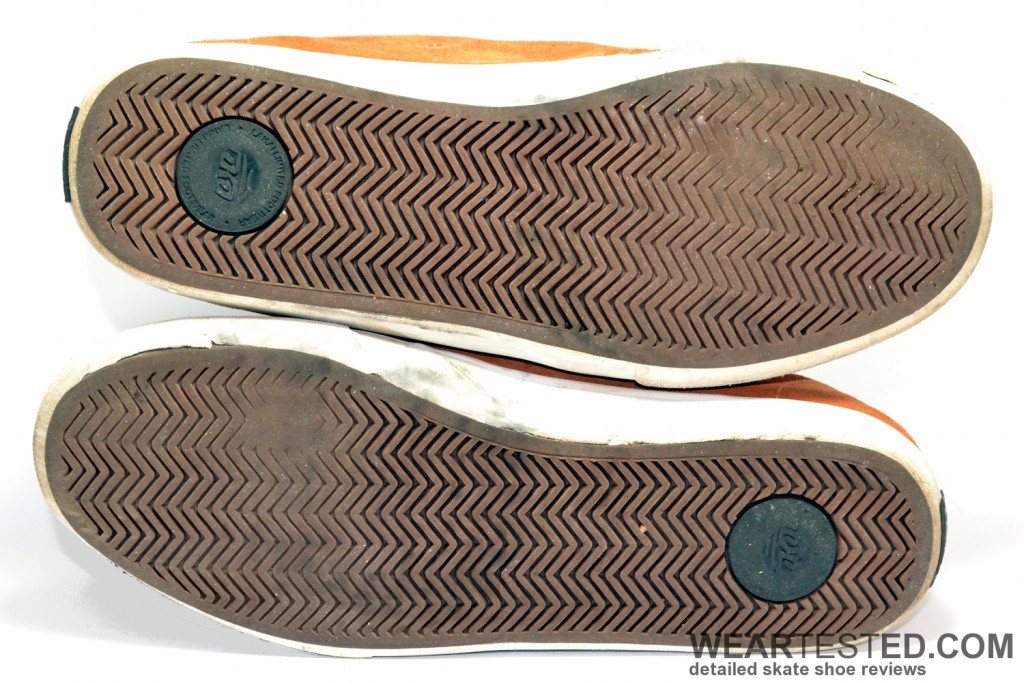 For this shoe, both are the case and in addition, the rough structure ensures a certain wear resistance as already mentioned in the durability paragraph. The result is a gimmick-less sole with the good adhesion that is typical for vulcanized constructions.
For this shoe, both are the case and in addition, the rough structure ensures a certain wear resistance as already mentioned in the durability paragraph. The result is a gimmick-less sole with the good adhesion that is typical for vulcanized constructions.
Except for two metal eyelets on the medial side, the Lakai Marc doesn’t feature any features that enable air exchange. As a result, the breathability is very limited and sessions in the summer heat can cause uncomfort inside the shoe. The minimal padding reduces the isolation of heat, but doesn’t eradicate the problem.
The Marc experiences a metamorphosis with wear. Out of the box it features a rather wide, dull frontal area.
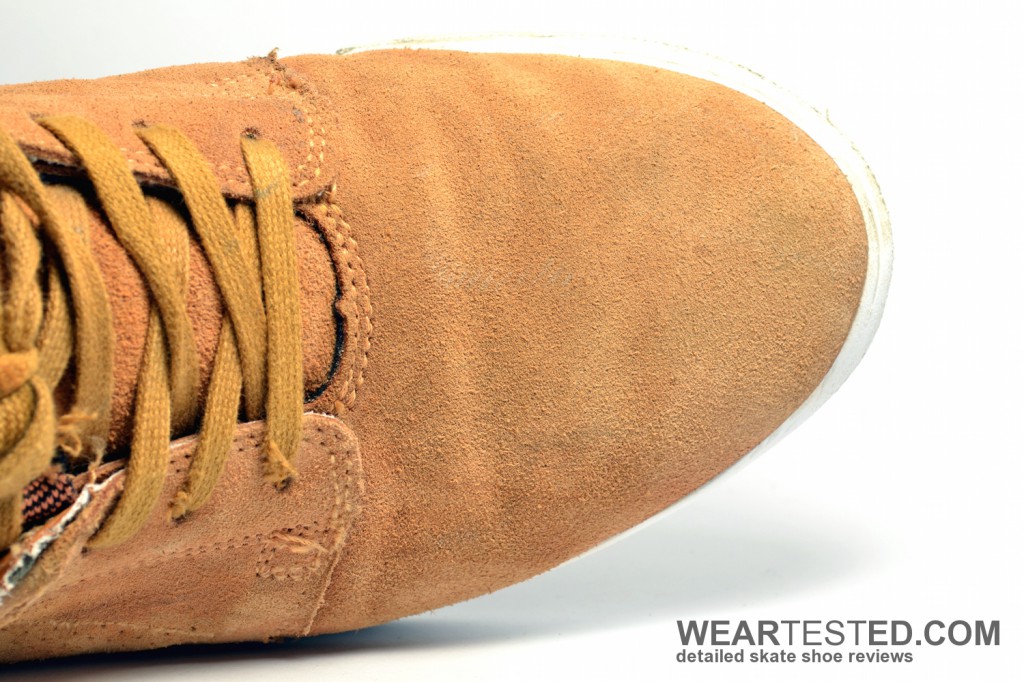 After a few sessions it gets softer, adapts to the toes like a suede sock and gets a more defined peak that offers majorly increased flick. While appearing to be a mid-top on the shelf, when worn it turns out to fit more like a low top without a cutout for the ankle.
After a few sessions it gets softer, adapts to the toes like a suede sock and gets a more defined peak that offers majorly increased flick. While appearing to be a mid-top on the shelf, when worn it turns out to fit more like a low top without a cutout for the ankle.
A main feature that plays an important role in the comfort of the Marc has already been mentioned earlier, which is the thick and soft removable insole. This avoids the typical problem that occurs with vulcanized soles, which are worn-down feet after sessions of more than 2 hours. A possible reason for this is a lack of protection. The rounded and soft collar is ankle-friendly and doesn’t cause blisters, hotspots or irritations around the Achilles tendon. The overall craftsmanship is well executed and the interior features only a minimal amount of seams. A minor drawback pertaining to the comfort are the lace-centering straps, but they fulfill their purpose and keep the minimally padded tongue in place.
Usually a sturdy and big plastic reinforcement in the heel of a skate shoe is the key feature for a supportive skate shoe. The Marc is an exception of the rule, to a certain degree. The collar is rather soft and can be squeezed together with ease, However, the extra half inch of thick leather makes it feel supportive when worn. The raised top doesn’t necessarily reduce freedom of ankle movement. In fact, it feels more protective and secure compared to a low cut, possibly because the anklebones rest on the collar, which in return applies a certain reinforcement. That aside, the Marc stretched out quite a bit, especially on the medial side. Keeping in mind that vulcanized low-cut models typically offer very little support, the Marc performs very well in this area. If needed, the support can be further increased when the top eyelet is laced.
The Lakai Marc is not an everyday vulcanized model. With a rather uncommon silhouette, improved support and solid cushioning, the Lakai Marc is a positive suprise. It also features good durability, boardfeel and grip. The only minor flaw is the below average breathability.
Follow us on facebook, twitter or @weartested on Instagram for weekly news, behind-the-scenes content, exclusive previews and pictures.
Comments are closed.

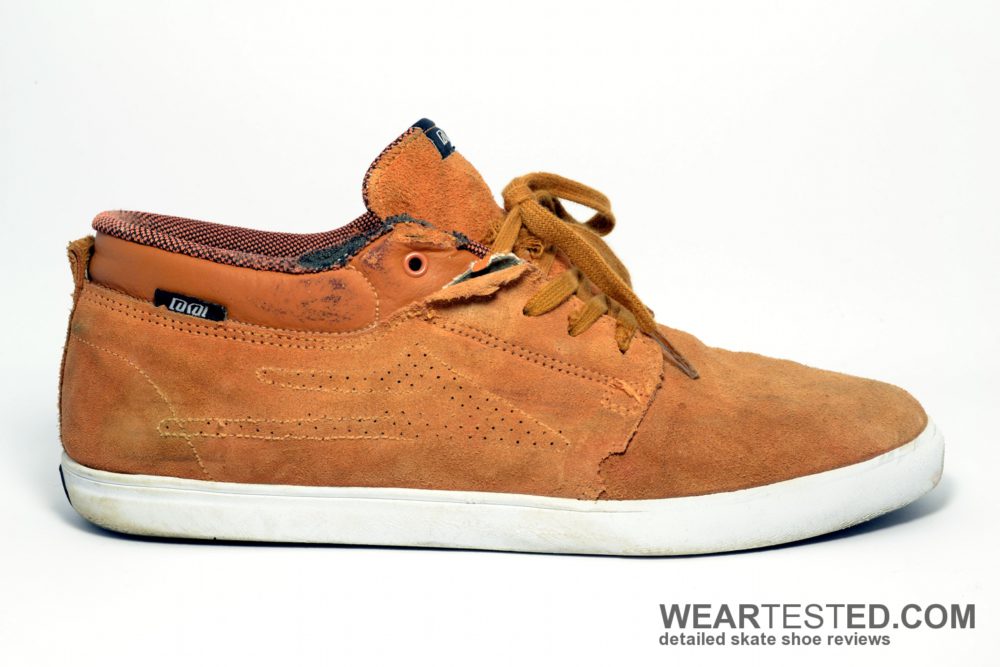
Stephanie
October 16, 2012I purchase a pair of Lakai shoes for my son and they didn’t even last 30 days…The sole completely detached from both shoes and I paid over $100 for these shoes. I have been purchasing skate shoes for both of my boys for the past 5 years and I am not too impressed with this!
Armin
October 16, 2012Hey,Stephanie. You do realize that not one pair of Lakai shoes is more then 100 $ ? Every single shoe is less then that.
Matt
October 17, 2012Great review, great shoe, great company! Hey Mom, Lakai are among the cheapest skate shoes out. Most are $50-$60, and if your kid actually skates everyday, 30 days is pretty good!
Kyle
October 23, 2012Lakai shoes are by far my favorite skate shoe.
A
October 26, 2012Good review, I’m getting these in the Thrasher colors. Do a review on the Emerica G-Codes, Lakai Manchester Select, or Nike SB Stefan Janoski.